1st Minnesota Infantry Regiment
The 1st Minnesota Infantry Regiment was a Union infantry regiment active during the American Civil War. The 1st Minnesota participated in the battles of First Bull Run, Antietam and the Battle of Gettysburg[1]. The regiment's most famous action occurred on the second day of the Battle of Gettysburg when Major General Winfield Scott Hancock ordered the 1st Minnesota to charge into a brigade of 1200 Confederate soldiers. This action blunted the Confederate attack and helped preserve the Union's precarious position on Cemetery Ridge.
| 1st Minnesota Infantry Regiment | |
|---|---|
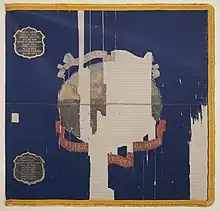 The regimental battle flag of the 1st Minnesota Volunteer Infantry Regiment consists of one layer of blue silk with a gold fringe border and the Minnesota State Seal painted in the center with the Minnesota State Motto over it in gold pigment. Beneath the seal is a painted red ribbon reading "FIRST MINNESOTA VOLUNTEERS." Two gold shields list the battles fought by the 1st Minnesota prior to April of 1863 when the flag was presented to the regiment by Governor Alexander Ramsey during his visit to the field. | |
| Active | April 29, 1861, to July 15, 1865 |
| Country | |
| Allegiance | Union |
| Branch | Infantry |
| Equipment | M1861 Springfield .58 Rifle-musket M1842 Springfield .69 Smoothbore M1842 Springfield .69 Rifle-musket Sharps .52 Rifle |
| Engagements | American Civil War
|
| Commanders | |
| Notable commanders | Colonel Willis A. Gorman Colonel Napoleon J.T. Dana Colonel Alfred Sully Colonel George N. Morgan Colonel William J. Colvill |
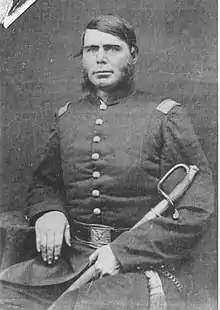
History
Organization and early service
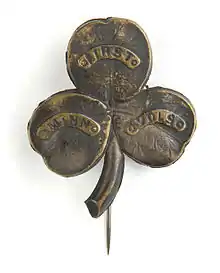
On April 14, 1861, Minnesota Governor Alexander Ramsey was visiting Washington DC. Upon hearing of the attack on Fort Sumter, Governor Ramsey offered President Lincoln 1000 men to fight the South. Word of the Governor's offer spread and communities back in Minnesota quickly raised groups of volunteers in support of Ramsey. The men mustered at the newly reactivated Fort Snelling. The men raised by the communities were sent there and mustered into the 1st Minnesota Infantry Regiment on April 29. They were the some of the first troops offered by any state to meet Abraham Lincoln's call for 75,000 men to assist the Federal Government deal with the secession. On May 10 they were remustered "officially" for three years service. From Fort Snelling they boarded river boats to go South to a rail line so they could head east.
Josias Redgate King of the St. Paul Pioneer Guard is credited as the first northern volunteer to stand to for Lincoln's call for men to fight the south.[2]
| Company | Earliest Moniker | Primary Location of Recruitment | Earliest Captain |
|---|---|---|---|
| A | Pioneer Guard | St. Paul | Alexander Wilkin |
| B | Stillwater Guard | Stillwater | Carlyle A. Bromley |
| C | St. Paul Volunteers | St. Paul | William H. Acker |
| D | Lincoln Guards | Minneapolis | Henry R. Putnam |
| E | St. Anthony Zouaves | St. Anthony | George N. Morgan |
| F | Red Wing Volunteers or Goodhue County Volunteers | Red Wing | William J. Colvill, Jr. |
| G | Faribault Guards | Faribault | William H. Dike |
| H | Dakota County Volunteers | Hastings | Charles Powell Adams |
| I | Wabasha Volunteers | Wabasha | John H. Pell |
| K | Winona Volunteers | Winona | Henry C. Lester |
| L | Sharpshooters | Rice & Steele Counties | William Russell |
First Bull Run
On July 21, 1861, near Manassas, Virginia, the regiment fought in the first major battle of the Civil War: the First Battle of Bull Run. While straddling Rickett's Battery in support, it saw heavy fighting on Henry House Hill in close proximity to the enemy. The 1st Minnesota was one of the last regiments to leave the battlefield and suffered among the highest casualties of any northern regiment: 49 killed, 107 wounded and 34 missing.[3]
During the 1st Minnesota Infantry's initiation to combat, its honorable conduct was readily distinguishable from that of the other regiments in its brigade:
The First Minnesota Regiment moved from its position on the left of the field to the support of Ricketts' battery, and gallantly engaged the enemy at that point. It was so near the enemy's lines that friends and foes were for a time confounded. The regiment behaved exceedingly well, and finally retired from the field in good order. The other two regiments of the brigade retired in confusion, and no efforts of myself or staff were successful in rallying them. I respectfully refer you to Colonel Gorman's report for the account of his regiment's behavior and of the good conduct of his officers and men.[4]
Antietam
During General John Sedgwick's ill-fated assault on the West Woods,[5] the regiment suffered significant casualties (1 officer killed, 3 officers wounded, 15 enlisted killed, 79 enlisted wounded, 24 enlisted missing, for a total of 122 [28%] of 435 engaged)[6] as Union forces were routed on that part of the field. The brigade commander noted, "The First Minnesota Regiment fired with so much coolness and accuracy that they brought down [three times one] of the enemy's flags, and finally cut the flag-staff in two."[7]
Gettysburg
July 2

The regiment's most famous action occurred during the second day's fighting at Gettysburg, when Major General Winfield Scott Hancock ordered the 1st Minnesota to charge into a brigade of roughly 1200 men of James Longstreet's corps and Richard H. Anderson's Division, which it did with roughly 250 men. They were outnumbered by at least 5 to 1, but it was Gen. Hancock's only option to buy time for reinforcements to arrive. One survivor stated afterward that he expected the advance to result in "death or wounds to us all".[8] The regiment immediately obeyed the order and Gen. Hancock was amazed at the unit discipline, valor, and the tremendous casualties taken in carrying out his order. This action blunted the Confederate attack and helped preserve the Union's precarious position on Cemetery Ridge at the end of the second day of the battle.
Maj. Gen. Winfield S. Hancock, commander of II Corps, could see two brigades of Southerners commanded by Brig. Gen. Cadmus M. Wilcox breaching the line in front of one of his batteries. He quickly rode up to the troops guarding the battery and asked Col. William Colvill "what unit is this?" Col. Colvill responded "the 1st Minnesota". Gen. Hancock responded "attack that line". With their bayonets leveled, the Minnesotans broke the first lines. The intensity of their charge disrupted the southern advance. With the unit nearly encircled, support arrived in time to allow some of them to make a fighting withdrawal. Their selfless charge bought the Union the time needed for reinforcements to be brought up. During the charge, 215[nb 1] of the 262 who made the charge became casualties within five minutes.[12] That included the unit commander, Col. William Colvill, and all but three of his captains.
The 1st Minnesota's flag lost five flag bearers, each man dropping his weapon to carry it on. The 47 survivors rallied back to General Hancock under the command of their senior surviving officer, Captain Nathan S. Messick. The 82% casualty rate stands as the largest loss by any surviving U.S military unit in a single day's engagement ever. The unit's colors are displayed in the rotunda of the Minnesota Capitol for public appreciation.
In his official report, Confederate Brigadier General Cadmus M. Wilcox perceived the inequality of the fight differently (bold emphasis likely refers to the First Minnesota):
This stronghold of the enemy [i.e., Cemetery Ridge], together with his batteries, were almost won, when still another line of infantry descended the slope in our front at a double-quick, to the support of their fleeing comrades and for the defense of the batteries. Seeing this contest so unequal, I dispatched my adjutant-general to the division commander, to ask that support be sent to my men, but no support came. Three several times did this last of the enemy's lines attempt to drive my men back, and were as often repulsed. This struggle at the foot of the hill on which were the enemy's batteries, though so unequal, was continued for some thirty minutes. With a second supporting line, the heights could have been carried. Without support on either my right or left, my men were withdrawn, to prevent their entire destruction or capture. The enemy did not pursue, but my men retired under a heavy artillery fire, and returned to their original position in line, and bivouacked for the night, pickets being left on the pike.[13]
July 3
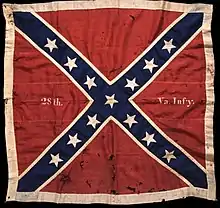

Carrying on from the heavy losses of the previous day, the remaining men of the 1st Minn. were reinforced by detached Companies F and L. The reunited regiment was moved a bit north of the previous day's fight to one of the few places where Union lines were breached during Pickett's Charge. They again had to charge into advancing Confederate troops with more losses. Capt. Messick was killed and Capt. W. B. Farrell mortally wounded, and Capt. Henry C. Coates had to take command. During this charge, Private Marshall Sherman of Company C captured the colors of the 28th Virginia Infantry[14] and received the Medal of Honor for this exploit. The Confederate flag was taken back to Minnesota as a war trophy, where it remains.
After being knocked out by a bullet to the head and later shot in the hand, Corporal Henry D. O'Brien repeatedly picked up the fallen colors of the 1st Minnesota and carried a wounded comrade back to the Union lines. He was also awarded the Medal of Honor for his heroism.
Later service
The 1st Minnesota continued to serve in the Army of the Potomac, participating later in 1863 in the Bristoe and Mine Run Campaigns. It was mustered out of service upon completion of its enlistment on April 29, 1864, at Fort Snelling. Enough of the regiment's veterans reenlisted to form the nucleus of the 1st Minnesota Volunteer Infantry Battalion, which returned to Virginia and served through the end of the war.[15] Others volunteered to serve in the 1st Minnesota Heavy Artillery Regiment including Colonel Colville.[16]
Post war
Post war, both General Hancock and U.S. President Calvin Coolidge were unrestrained in their praise for the actions of the 1st Minnesota. Gen. Hancock, who witnessed the action firsthand, placed its heroism highest in the annals of war:[17] "No soldiers on any field, in this or any other country ever displayed grander heroism". Gen. Hancock ascribed unsurpassed gallantry to the famed assault stating: "There is no more gallant deed recorded in history".[18] Emphasizing the critical nature of the circumstances on July 2 at Gettysburg, President Coolidge considered: "Colonel Colvill and those eight companies of the First Minnesota are entitled to rank as the saviors of their country".[19]
Minnesota has two monuments at the Gettysburg National Military Park. The more grand of the two bears the inscription:
On the afternoon of July 2, 1863 Sickles' Third Corps, having advanced from this line to the Emmitsburg Road, eight companies of the First Minnesota Regiment, numbering 262 men were sent to this place to support a battery upon Sickles repulse.
As his men were passing here in confused retreat, two Confederate brigades in pursuit were crossing the swale. To gain time to bring up the reserves & save this position, Gen Hancock in person ordered the eight companies to charge the rapidly advancing enemy.
The order was instantly repeated by Col. Wm Colvill. And the charge was instantly made down the slope at full speed through the concentrated fire of the two brigades breaking with the bayonet the enemy's front line as it was crossing the small brook in the low ground there the remnant of the eight companies, nearly surrounded by the enemy held its entire force at bay for a considerable time & till it retired on the approach of the reserve the charge successfully accomplished its object. It saved this position & probably the battlefield. The loss of the eight companies in the charge was 215 killed & wounded. More than 82% percent. 47 men were still in line & no man missing. In self sacrificing desperate valor this charge has no parallel in any war. Among the severely wounded were Col. Wm Colvill, Lt Col. Chas P Adams & Maj. Mark W. Downie. Among the killed Capt. Joseph Periam, Capt. Louis Muller & Lt Waldo Farrar. The next day the regiment participated in repelling Pickett's charge losing 17 more men killed & wounded.[20]
Casualties
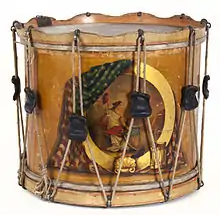
The 1st Minnesota Infantry suffered the loss of 10 officers and 177 enlisted men killed in action or who later died of their wounds, plus another 2 officers and 97 enlisted men who died of disease, for a total of 286 fatalities[15] and 609 wounded.
Bull Run
Antietam
Gettysburg
Bristow
Petersburg
Continued lineage
The 2nd Battalion, 135th Infantry Regiment, 34th Infantry Division (Minnesota Army National Guard) traces its roots back to the historic 1st Minnesota Volunteers.
Notes
- The 215 casualty figure is disputed. Morning muster on July 2 for companies A, B, D, E, G, H, I & K, involved in the assault, was 262 with the evening muster 47. To arrive at the casualty figure of 215, the Regimental Historian (Lt. Wm. Lochren) subtracted the muster figures (262-47=215)(82.1%) and asserted that "[every one of the] 215 [missing men] lay upon the field."[9] Conducting an enumeration by individual names in 1982, Robert W. Meinhard of Winona State University accounted for only 179 (68.3%) casualties for the single day of July 2, 1863.[10][11] Whether Meinhard's and Lochren's conclusions are based upon the exact same records is unknown; accounting for the disputed 36 (=215-179) men remains unresolved.
Bibliography
- Andrews, C. C., ed. (1891). Minnesota in the Civil and Indian Wars 1861-1865. St. Paul, Minn: Printed for the state by the Pioneer Press Co. OL 7088819M.
References
- Moe, Richard (1993). The Last Full Measure: The Life and Death of the First Minnesota Volunteers. St. Paul, MN: Minnesota Historical Society Press. p. 63. ISBN 978-087351406-4.
- King, Josias R. (1832–1916), MNopedia, Brian Leehan, Minnesota Historical Society, St. Paul, Minnesota
- "Report of Col. Willis A. Gorman, First Minnesota Infantry; O.R.–SERIES I–VOLUME 51 Part 1 [S# 107]". Bull Runnings. 2008-09-25. pp. 20–23. Retrieved 2011-09-26.
- Franklin, Col. William B. "Report of Col. William B. Franklin, Twelfth U. S. Infantry, Commanding First Brigade, Third Division". Civil War Reference. Archived from the original on 2016-03-12. Retrieved 2012-09-27.
- Antietam on the Web. "Gorman's Brigade, Sedgwick's Division". Retrieved 2012-08-04.
- Antietam on the Web. "Col Alfred Sully's Official Report". Retrieved 2012-08-04.
- Gorman, Brigadier General Willis A. "Report of Brig. Gen. Willis A. Gorman, U.S. Army, Commanding First Brigade, of the Battle of Antietam SEPTEMBER 3-20, 1862.-The Maryland Campaign. O.R.-- SERIES I--VOLUME XIX/1 [S# 27]". Civil War Home. Retrieved 27 September 2012.
- Lochren, Lieutenant William (July 2, 1897). Dedicatory Address, First Minnesota Monument (Speech). Gettysburg National Military Park. Cited in Colvill Commission (1916). History of the First Regiment Minnesota Volunteer Infantry, 1861-1864. Stillwater, MN: Easton & Masterman. pp. 344.
Every man realized in an instant what that order meant. Death or wounds to us all—the sacrifice of the regiment to gain a few minutes time and save the position and probably the battlefield, and every man saw and accepted the necessity for that sacrifice, and responding to Colvill's rapid orders the regiment in perfect line, with arms at right shoulder shift was in a moment down that slope directly upon the enemy's center.
- Colville Commission (1916). History of the First Regiment Minnesota Volunteer Infantry, 1861-1864. Stillwater, MN: Easton & Masterman. pp. 345.
- Maciejewski, Jeffrey (July 2011). "Buying Time". America's Civil War: 50.
- Meinhard, Robert W. (20 May 1982), Letter to Tom Harrison, Chief Historian, Gettysburg National Military Park cited in Moe, Richard (1993). The Last Full Measure: The Life and Death of the First Minnesota Volunteers. St. Paul, MN: Minnesota Historical Society Press. p. 275. ISBN 978-087351406-4.
- 1st Minnesota Casualities, The Goodhue Volunteer, July 22, 1863, p.3, Minnesota Digital Newspaper Hub, 2023, Minnesota historical Socieety, 345 Kellogg Blvd, St. Paul, Mn
- Wilcox, Brig. Gen Cadmus M. "Official Report, The Gettysburg Campaign". Home of the American Civil War. Retrieved 25 August 2012.
- research file (MOLLUS at Gettysburg Discussion Group website)
- Civil War Archive website regimental history
- Andrews, p. 612.
- Tucker, Glenn (1960). Hancock the Superb. New York: The Bobbs-Merrill Co., Inc. pp. 145.
No soldiers on any field, in this or any other country, ever displayed grander heroism.
- Folwell, William Watts (1961). A History of Minnesota, Vol II. St. Paul, MN: Minnesota Historical Society. p. 311.
There is no more gallant a deed recorded in history.
- The American Presidency Project. "Address Dedicating a Memorial to Col. William Colvill, Cannon Falls, Minn. July 4, 1928". Retrieved 2012-09-10.
- "DCMemorials.com". Archived from the original on 2016-09-27. Retrieved 2007-07-07.
Further reading
- Imholte, John Q., The First Volunteers: History of the first Minnesota Volunteer Regiment, 1861-1865. Minneapolis: Ross & Haines, 1963. Out of print.
- Moe, Richard, The Last Full Measure: The Life and Death of the First Minnesota Volunteers. St. Paul, MN: Minnesota Historical Society Press, 1993, ISBN 978-087351406-4.
External links
- Roster of the First Minnesota
- Poem: The Charge of the First Minnesota
- Lieutenant William Lochren's account of the First Minnesota at Gettysburg, read January 14, 1890.
- Leehan, Brian. Pale Horse at Plum Run: The First Minnesota at Gettysburg
- 1st Minnesota Regiment Monument at Gettysburg Archived 2016-09-27 at the Wayback MachineNational Guard Heritage Series Painting of the First Minnesota at Gettysburg.
- Manuscript collections about the First Minnesota are available for research use at the Minnesota Historical Society
- First Minnesota, Co D ~ Lincoln Guards living history organization
- Photo of the Day: 1st Minnesota Monument at Gettysburg
- From the Journal of Sgt. Sam Bloomer, 1st Minnesota Volunteer Infantry April 29 - May 3, 1861
- From the Journal of Sgt. Sam Bloomer, 1st Minnesota Volunteer Infantry Company B, Dec. 24, 1861-Jan. 9, 1862
- The bridge that saved an Army: Grapevine Bridge and the Battle of Fair Oaks
- The First Minnesota in MNopedia
- Minnesota Historical Society resources on Minnesota and the Civil War
- History of the First Regiment Minnesota Volunteer Infantry, 1861-1864: with maps and illustrations (1916) at the Internet Archive
- Hush - What Was the Civil War Really About - A documentary about the 1st Minnesota Volunteer Infantry and the Civil War
http://sbv.hatinh.gov.vn/upload/tailieu/thuoc-chong-tram-cam-52-16280737159.htm http://pyttkvtphcm.gov.vn/question/thuoc-chong-tram-cam-va-luu-y-khi-dung/ Archived 2021-08-12 at the Wayback Machine